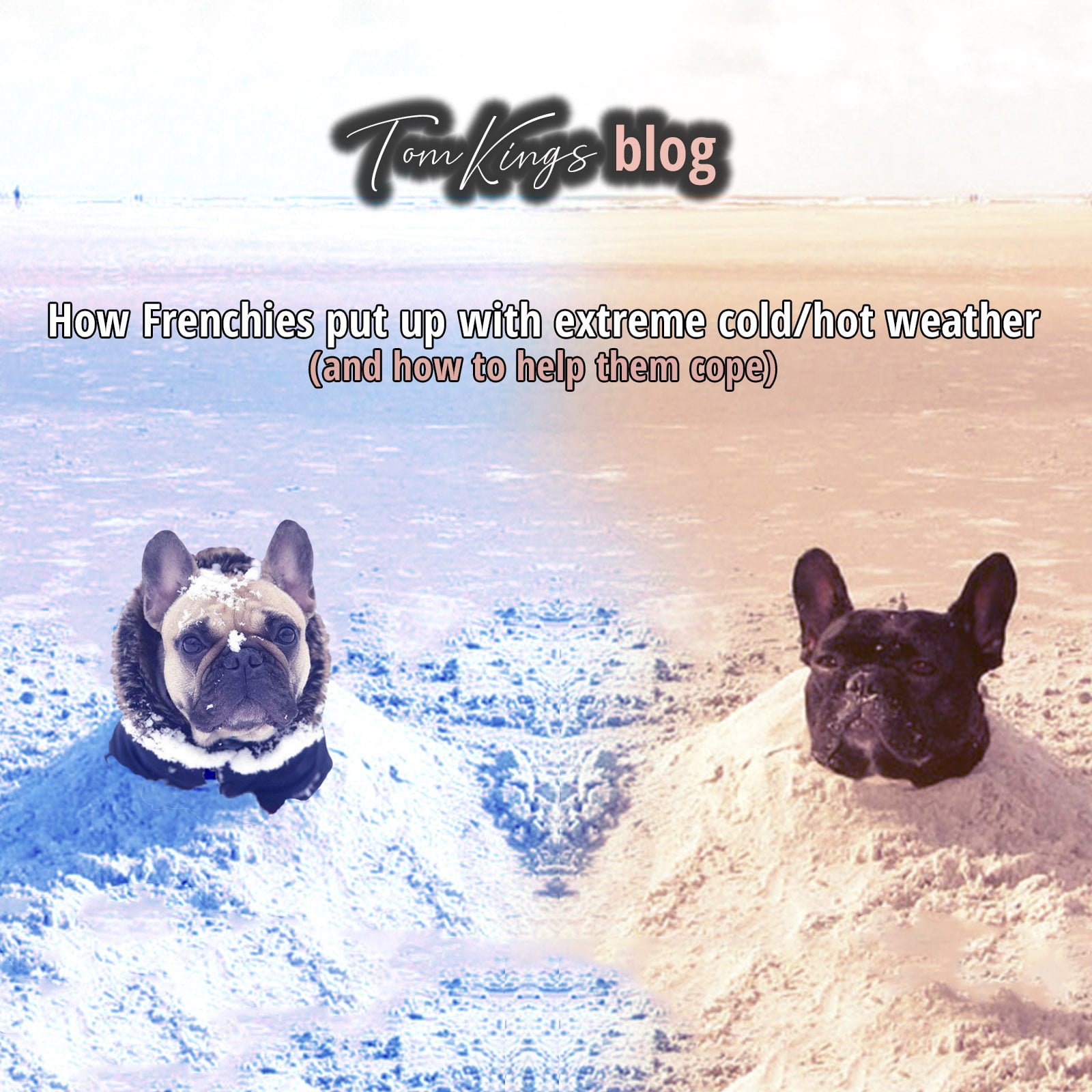French Bulldogs are known for their adorable appearance and playful personalities, but have you ever wondered how they handle different temperatures? These compact and muscular canines have a unique tolerance when it comes to temperature extremes. While they are not built for extreme cold or heat, French Bulldogs can handle a wide range of temperatures with proper care and precautions.
French Bulldogs originated from the toy bulldogs that were popular in England during the 1800s. These dogs were bred for companionship and were often kept indoors. Their short snouts and brachycephalic skulls make them prone to overheating, especially in hot and humid conditions. In fact, French Bulldogs are at greater risk of heatstroke compared to other breeds. It is crucial to provide them with a cool and well-ventilated environment, access to fresh water, and avoid excessive exercise during hot weather. Taking these measures can help ensure the well-being of these beloved pets.
French Bulldogs are sensitive to temperature extremes and can struggle in both hot and cold weather. They are prone to heat exhaustion and heatstroke in temperatures above 85°F (29°C). As for cold weather, anything below freezing (32°F or 0°C) can be dangerous for them. It’s crucial to provide them with adequate shelter, hydration, and never leave them outside for extended periods in extreme temperatures.

Keeping French Bulldogs Comfortable: Understanding Their Temperature Tolerance
French Bulldogs are beloved for their distinctive appearance and friendly personalities. These small, compact dogs have a unique body structure, including their short snouts and brachycephalic faces. These features can make them more susceptible to heat-related issues and make it important for owners to understand the temperature that French Bulldogs can handle. In this article, we will explore the temperature range that French Bulldogs can tolerate and provide tips on how to keep them comfortable in different weather conditions.
Ideal Temperature Range for French Bulldogs
French Bulldogs are a brachycephalic breed, which means they have a shortened snout and a compressed airway. This anatomy makes it harder for them to regulate their body temperature, especially in hot and humid weather. French Bulldogs are more prone to heat exhaustion and heatstroke compared to other breeds, and their ideal temperature range is narrower as a result.
The ideal temperature range for French Bulldogs is between 60°F (15°C) and 75°F (24°C). This range ensures that they are neither too cold nor too hot. French Bulldogs can tolerate slightly higher temperatures, but it is essential to monitor them closely to prevent overheating.
On the lower end of the spectrum, French Bulldogs may start feeling discomfort and become susceptible to cold-related issues below 50°F (10°C). It is important to provide them with adequate warmth during colder weather to help them stay comfortable.
Signs of Overheating in French Bulldogs
French Bulldogs can quickly overheat, leading to severe health issues if not addressed promptly. It is crucial for owners to be aware of the signs of overheating to ensure the well-being of their furry friends. Some common signs of overheating in French Bulldogs include:
- Excessive panting
- Difficulty breathing
- Excessive drooling
- Bright red tongue and gums
- Vomiting or diarrhea
- Weakness or collapse
- Trembling
If you notice any of these signs in your French Bulldog, it is crucial to take immediate action to cool them down and prevent further complications. Move them to a cool and shaded area, provide fresh water, and offer a wet towel or cooling pad for them to lie on.
Tips for Keeping French Bulldogs Comfortable
To ensure the comfort and well-being of your French Bulldog in different temperature conditions, here are some tips to keep in mind:
1. Keep them hydrated
Proper hydration is crucial for French Bulldogs, especially in warmer weather. Make sure they always have access to clean and fresh water. Consider using a water bottle designed for pets when going for walks or spending time outdoors.
2. Avoid exercising during the hottest part of the day
Engaging in rigorous physical activity during the hottest hours of the day can put your French Bulldog at risk of overheating. Schedule walks and playtime in the early morning or late evening when the temperatures are cooler.
3. Provide shade and a cool resting area
Create a shaded area in your yard where your French Bulldog can relax and cool down. You can also set up a cooling pad or provide a well-ventilated space indoors with a fan or air conditioning.
4. Avoid leaving them in a parked car
Under no circumstances should you leave your French Bulldog in a parked car, even for a short period. The temperature inside a car can rise to dangerous levels rapidly, leading to heatstroke and potential fatality.
5. Familiarize yourself with heatstroke first aid
It is essential to be prepared and know how to respond in case of a heatstroke emergency. Familiarize yourself with the steps for heatstroke first aid and have the necessary supplies readily available.
6. Dress for the weather
Consider dressing your French Bulldog in lightweight and breathable clothing during colder temperatures to provide extra warmth. However, avoid overdressing them, as it can lead to overheating.
Conclusion
French Bulldogs have a narrower temperature tolerance range compared to other breeds due to their brachycephalic anatomy. It is vital for owners to be mindful of their French Bulldog’s comfort and take necessary precautions to prevent overheating. By following the tips mentioned in this article and paying attention to their body language and behavior, you can help ensure that your French Bulldog stays happy and healthy in various weather conditions.
Comparison of French Bulldogs’ Temperature Tolerance with Other Breeds
When it comes to temperature tolerance, different dog breeds have varying abilities to handle extreme temperatures. Here’s a comparison of French Bulldogs’ temperature tolerance with some other popular dog breeds:
| Breed | Ideal Temperature Range |
| French Bulldog | 60°F (15°C) – 75°F (24°C) |
| Labrador Retriever | 50°F (10°C) – 80°F (27°C) |
| Siberian Husky | -60°F (-51°C) – 75°F (24°C) |
| Pug | 60°F (15°C) – 75°F (24°C) |
Key Takeaways
- French Bulldogs are sensitive to extreme temperatures and can struggle in both hot and cold weather.
- They are more susceptible to heatstroke and heat exhaustion in high temperatures above 85°F (29°C).
- In cold weather, it is important to protect French Bulldogs from freezing temperatures below 32°F (0°C) to prevent hypothermia.
- Providing shade, fresh water, and a cool environment is crucial to keeping French Bulldogs safe in hot weather.
- During colder weather, it is recommended to dress your French Bulldog in a warm sweater or coat and limit outdoor time.
Frequently Asked Questions
Here are some common questions about the temperature that French Bulldogs can handle.
1. Can French Bulldogs tolerate hot weather?
French Bulldogs are more sensitive to heat than other breeds due to their brachycephalic (short-muzzled) faces. They are prone to overheating and can struggle to cool themselves down. It is important to keep them in a cool environment and avoid exercising them during the hottest parts of the day. Providing them with plenty of shade, fresh water, and a cool place to rest is essential to prevent heatstroke.
Additionally, it is crucial to never leave a French Bulldog alone in a hot car, as this can quickly lead to a life-threatening situation. It is best to keep them in an air-conditioned environment or provide them with a fan during hot weather.
2. Can French Bulldogs handle cold weather?
French Bulldogs are sensitive to extreme cold temperatures, as they are not well-suited for harsh climates. While they can handle moderate cold weather, it is important to provide them with appropriate protection to keep them warm. This can include a well-insulated dog house or a cozy coat or sweater to wear when outdoors in chilly temperatures. Monitor their behavior and bring them indoors if they show signs of discomfort or shivering.
It is crucial to note that French Bulldogs should not be left outside for extended periods in freezing conditions or during severe weather events. Frostbite and hypothermia can occur if adequate precautions are not taken.
3. What is the ideal temperature range for French Bulldogs?
The ideal temperature range for French Bulldogs is between 60 to 80 degrees Fahrenheit (15 to 27 degrees Celsius). They are most comfortable in mild, temperate climates where the temperature is neither too hot nor too cold. It is important to monitor their behavior and provide appropriate measures to keep them comfortable in extreme weather conditions.
4. How can I help my French Bulldog stay comfortable in hot weather?
To help your French Bulldog stay comfortable in hot weather, you can take several precautions:
1. Keep them in an air-conditioned environment or provide them with access to fans.
2. Avoid walking or exercising them during the hottest parts of the day.
3. Provide plenty of shade and access to fresh water at all times.
4. Use cooling products such as cooling mats or vests to help lower their body temperature.
5. Avoid leaving them unattended in a hot car.
5. How can I help my French Bulldog stay warm in cold weather?
To help your French Bulldog stay warm in cold weather, you can take the following measures:
1. Provide them with a well-insulated dog house or a warm indoor space.
2. Dress them in a coat or sweater when going outside in chilly temperatures.
3. Avoid leaving them outside for extended periods in freezing weather.
4. Monitor their behavior and bring them indoors if they show signs of discomfort.
Remember, the key is to provide a comfortable and safe environment for your French Bulldog based on the specific weather conditions they are exposed to.

5 Things You Must Never Do to Your French Bulldog
In summary, French Bulldogs are sensitive to extreme temperatures and are prone to heatstroke. They can handle temperatures between 60-80 degrees Fahrenheit, but any temperatures outside of this range can be dangerous for them.
It’s important to provide them with a cool and shaded environment, access to fresh water, and avoid exercising them during hot weather to prevent overheating. Additionally, during cold weather, it’s crucial to keep them warm with proper insulation and clothing to protect them from the cold.
